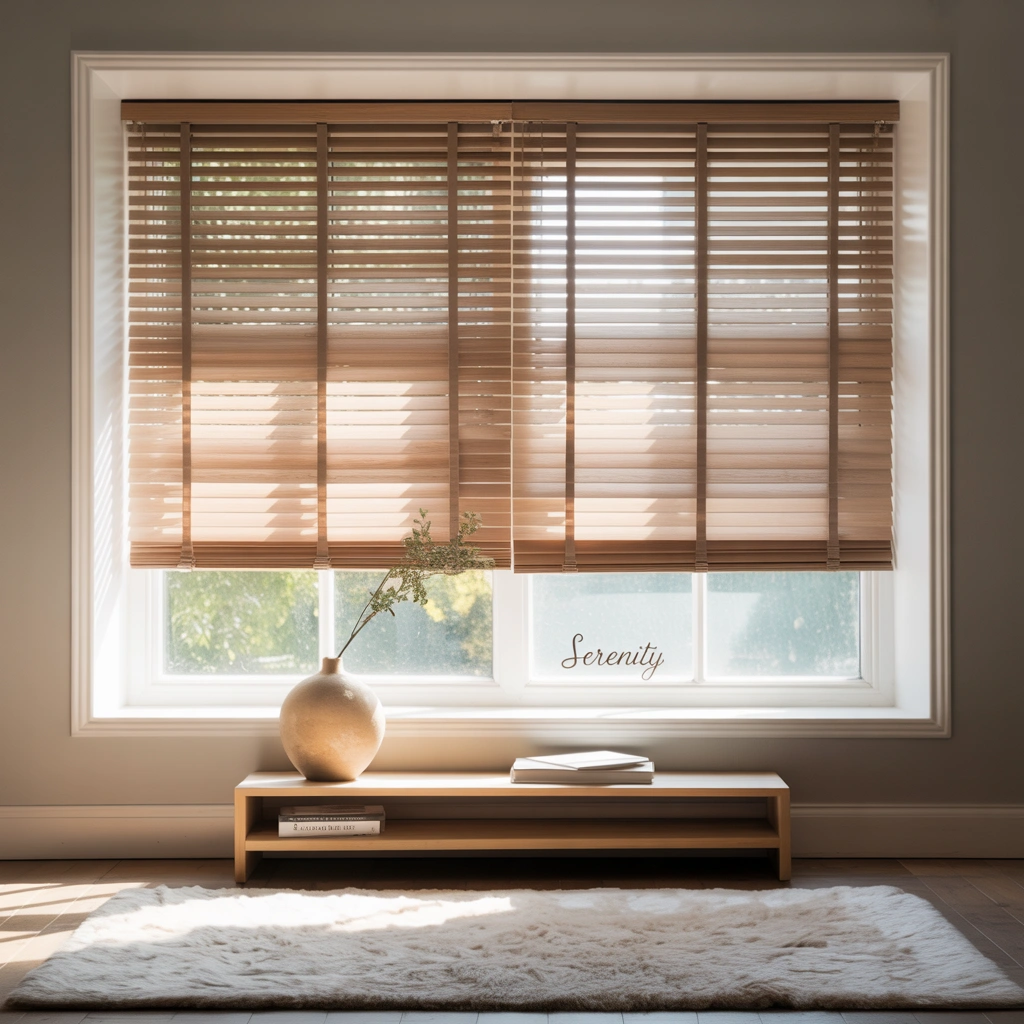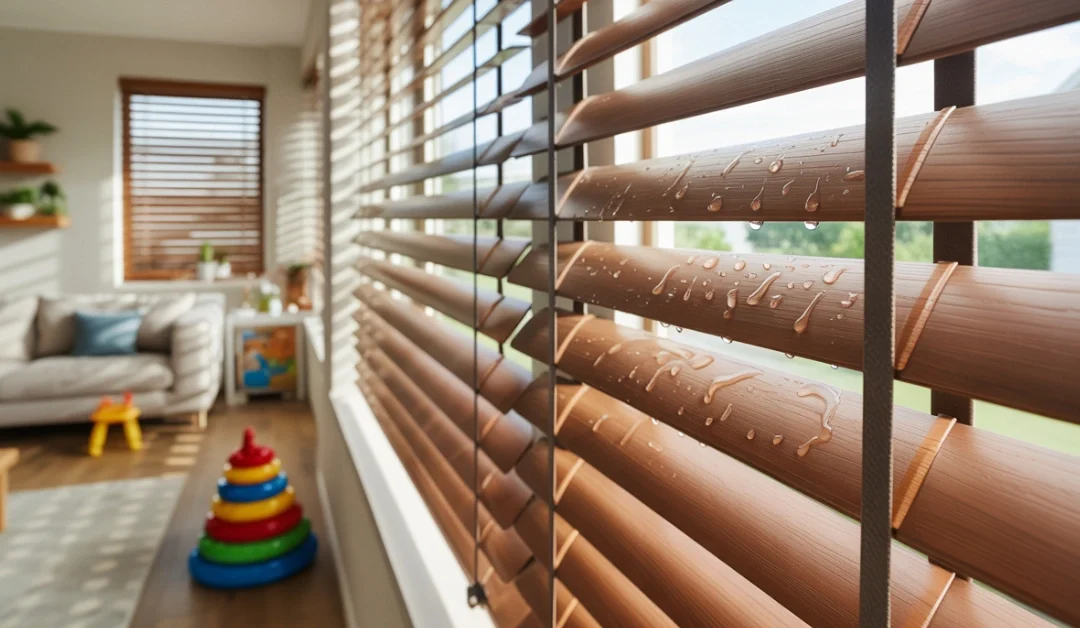Faux wood blinds are a popular choice for homes because they look like real wood but cost less. But are they safe? Will they last long? This guide answers these questions and more, using easy words and facts you can trust.
1. What Exactly Are Faux Wood Blinds Made Of?

Faux wood blinds are made by mixing plastic and wood particles. The most common materials used are:
1. PVC (Polyvinyl Chloride)
PVC is a type of plastic that is strong and waterproof. It is often used to make the slats of faux wood blinds. This material helps the blinds resist moisture, making them perfect for kitchens or bathrooms.
2. Vinyl
Vinyl is soft and flexible. It is used to coat the blinds, giving them a smooth finish. Vinyl helps the blinds look like real wood by copying its texture and color.
3. Composite Materials
Some faux wood blinds are made from a mix of recycled wood fibers and plastic. These are called composite blends. They are designed to feel heavier and more like real wood.
Why are these materials used?
They are chosen because they are lightweight, cheap to make, and easy to clean.
2. Are Faux Wood Blinds Safe for My Family and Home?
Do Faux Wood Blinds Release Toxic Chemicals?
Most modern faux wood blinds are non-toxic. However, older models (made before 2010) might contain harmful chemicals like lead or phthalates. These chemicals can be dangerous if they are released into the air.
Newer blinds are tested to meet safety standards like:
- OEKO-TEX®: Checks for harmful substances.
- CPSIA (Consumer Product Safety Improvement Act): Ensures products are safe for children.
Always ask the seller or manufacturer if their blinds are BPA-free or non-toxic.
Are They Safe for Kids and Pets?
Yes! Faux wood blinds are safe for families. They are strong and won’t break easily. However, the cords on some blinds can be dangerous for little kids or pets.
Solutions:
- Choose cordless blinds.
- Use safety clips to keep cords out of reach.
Are PVC or Vinyl Blinds Non-Toxic?
Most PVC or vinyl blinds are safe today. They are treated to reduce bad smells (called off-gassing ) that might come from new products.
If your blinds smell odd when you open the box, leave them in a sunny room for a day. The smell will go away.
Do They Meet Fire Safety Standards?
Many faux wood blinds are made with fire-resistant chemicals. They are less likely to catch fire than real wood. Always check the label for fire safety ratings like NFPA 701 (a standard for fire-resistant fabrics).
3. Are Faux Wood Blinds Durable Enough for Long-Term Use?

Can Faux Wood Blinds Handle Moisture and Humidity?
Yes! Faux wood blinds are perfect for wet rooms like bathrooms and kitchens. Unlike real wood, they won’t rot or warp when exposed to steam or water.
Why?
The PVC and vinyl materials used in faux wood blinds are waterproof. They can handle humidity better than natural wood.
Do They Warp, Crack, or Fade Over Time?
Faux wood blinds are designed to resist warping and cracking. However, if left in direct sunlight for many years, they might fade or become brittle.
Tips to Prevent Fading:
- Choose UV-resistant blinds.
- Close the blinds during peak sunlight hours.
How Long Do Faux Wood Blinds Typically Last?
Most faux wood blinds last 5–10 years, depending on how well they are cared for. They are cheaper to replace than real wood blinds.
How Do They Compare to Real Wood in Terms of Durability?
Real wood blinds are elegant but can be damaged by water or bugs. Faux wood blinds are better for humid areas and need less care.
| Feature | Faux Wood Blinds | Real Wood Blinds |
|---|---|---|
| Water Resistance | High | Low |
| Maintenance | Easy | High (needs polishing) |
| Lifespan | 5–10 years | 10–20 years |
| Cost | $50–$200 per window | $200–$500 per window |
4. What Are the Disadvantages of Faux Wood Blinds?
Are There Environmental Concerns with Faux Wood Blinds?
Faux wood blinds are made of plastic, which is not eco-friendly. They cannot be recycled easily and might end up in landfills.
Solutions:
- Look for blinds made from recycled materials.
- Donate old blinds to thrift stores instead of throwing them away.
Do They Off-Gas or Emit Unpleasant Odors?
New blinds might have a chemical smell, called off-gassing. This goes away after a few days if aired out.
Are They Heat-Sensitive or Prone to Warping in Extreme Temperatures?
Faux wood blinds can melt near fireplaces or get soft in very hot rooms. Keep them away from heat sources.
Do They Look as Good as Real Wood Blinds?
They look like wood but might feel fake up close. Real wood has a natural beauty that is hard to copy.
5. Final Thoughts
Faux wood blinds are a great mix of style and practicality. They are safe, durable, and budget-friendly, but they might not be the best choice if you care a lot about eco-friendliness or want the luxury of real wood. For most homes, though, they are a smart pick!
6. Frequently Asked Questions (FAQs)
Yes, but use cordless designs to avoid choking hazards.
Yes! They are water-resistant and perfect for wet rooms.
Most newer blinds are BPA-free. Check the packaging or ask the seller.
They are treated to be fire-resistant but not fireproof.
Some fading might happen over time, but UV-resistant models last longer.

